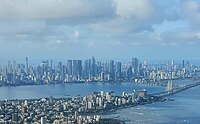
Photo from wikipedia
Nowadays, emerging industries are emerging, and the sports industry has become a remarkable new economic growth point. Vigorously tapping the potential of residents' sports consumption has important theoretical and practical… Click to show full abstract
Nowadays, emerging industries are emerging, and the sports industry has become a remarkable new economic growth point. Vigorously tapping the potential of residents' sports consumption has important theoretical and practical significance for promoting the development of the sports industry, improving people's living standards, and stimulating economic growth. In this paper, a deep learning model is constructed, and the random forest and random network models in the deep learning network are used to analyze the pulling effect of urban residents' sports consumption on economic growth. Since the consumption level of urban residents is much higher than that of rural residents, urban residents are in a dominant position in sports consumption, so this paper takes urban residents' sports consumption as the core to explore the pulling effect of urban residents' sports consumption on economic growth. The research theme of this paper is the pulling effect of urban residents' sports consumption on economic growth, so this paper sets the explanatory variable as the added value of GDP, expressed by GDP. Sports consumption has the characteristics of inevitability, gradualness, and diversity. With the continuous change of people's living standards, sports consumption also presents several stages of relative consumption pattern changes. Research shows that sports consumption has a positive role in promoting economic growth and the transformation and upgrading of economic development mode. Every one percentage point change in sports consumption leads to an economic growth of 0.186 percentage points, and with the increase of the lag period, urban residents' sports consumption will gradually increase the driving effect of economic growth. This effect can be analyzed at the micro- and macrolevels and enhanced by a causal cumulative cycle mechanism.
Journal Title: Computational Intelligence and Neuroscience
Year Published: 2022
Link to full text (if available)
Share on Social Media: Sign Up to like & get
recommendations!